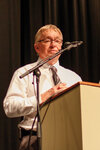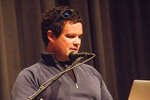


CHELAN – Citizens for Fire District 7 conducted an informational public meeting at the Performing Arts Center within Chelan High School, Wednesday, April 4. The intent of the meeting was to not only present facts on both the benefits and the risks involved with a levy LID lift, but also to answer any lingering questions from the community. The levy, which is placed on the ballot for April’s special elections, is requesting an additional 40 cents to the existing 92 cents per thousand Chelan residents currently pay in their property taxes for the fire district, for an annual total of $1.32 per thousand of assessed property value. The levy, if not passed, does not eliminate the 92 cents per thousand already being paid, that will remain in place. Instead, the new levy, if passed, will add 40 cents to what is already being paid in taxes.
In the Chelan Fire and Rescue’s (CFR) fact sheet, approximated cost comparisons are provided based on the assessed value of a resident’s home. Currently, at 92 cents per thousand, a home with an assessed value of $400,000 will pay around $368 a year for fire tax. That same home, with the proposed 40 cent increase, will see just over $150 in increase with an anticipated annual fire tax of $528, which breaks down to $44 monthly.
Leading into the meeting, Commissioner Russ Jones began by explaining the situation. “The biggest challenge for me has been to try and gather input from the community,” he began, “and unfortunately, we don’t see a lot of people at our meetings to come and talk to us and tell us what they think. Part of this ballot is to try and get that feedback from the community.” He then began to address comments echoed throughout the community, “I’ve been examining some of the questions that I get and some of the common misconceptions or misunderstandings that I get. One of the biggest is how our revenue works,” he voiced, “In the community, I’ve heard a lot of people talking about how the assessed value of the community has gone up and up and up, and I think it’s around $2 billion or so,” he suggested, “as that assessed valuation of the community goes up, that doesn’t necessarily mean that our revenue goes up. If we collected $100 last year, the most we could collect without doing a LID lift is $101,” he emphasized, then added, “it doesn’t matter if our assessed value goes up $500 million or $1 billion or anything else. So, when we have inflation that’s been running two or three percent, wages tend to go up, cost of equipment tends to go up. If we’re limited to one percent, we can’t keep up. Eventually those lines are going to cross, and we have to find ways to cut costs.”
Jones voiced that he appreciates the one-percent cap and its ability to keep taxes down over time, however “we can’t keep up with the growth in our community and we’ve been hearing a lot about growth lately,” he emphasized with concern, “and that presents additional demands and challenges for us. I’ve spent the last two years trying hard to learn the role of commissioner. It’s a lot more challenging than I expected, but I’ve been trying to build, for myself at least, what some of the main criteria are and decision making of the criteria.” He then offered a couple of the criteria used for his decision making, including whether or not the decision will help save lives and/or reduce suffering. “In the case of this debate of whether we have career staff or not,” he explained, “statistically we know that career staff will arrive sooner. Volunteers respond from home. If you have a coronary situation, that’s pretty important. If you have a fire, you only have so much time before a flashover occurs and a structure is lost. Will it reduce damage to property? Same thing applies.”
The presentation took place with the use of informational slides, providing statistics on the levy. “This (levy) will generate $660,000 in funding to retain the six firefighters currently funded by a federal grant … another $150,000 will be generated for additional funding for equipment replacement … finally, the lift will fund an additional $50,000 for volunteer programs and stipend shifts.”
One slide, in particular, stated notable statistics. The slide, addressing the question as to why Chelan needs more “in-station firefighters” than other communities, provided peak weekend population statistics. Most locals have heard the standard, “Chelan doubles in size during the peak season,” or at least something similar. But, what does it look like when you place a number to it? According to Chamber of Commerce websites, Leavenworth at its peak weekends has a population of 35,000. Chelan surpasses that number with an eye-opening 50,000 people during peak weekends.
The multi-skilled department faces a number of day-to-day challenges and tasks that are not necessarily in the public eye, because on average, statistically, on-staff personnel allow shorter response times, by several minutes, in comparison to volunteers.
For access to the district’s information packed fact sheet, visit their website at www.Chelan7.com, or for the slideshow presentation from the Citizens for Fire District 7’s meeting, visit them on Facebook at www.facebook.com/citizensforfiredistrict7 .
Comments
No comments on this item Please log in to comment by clicking here